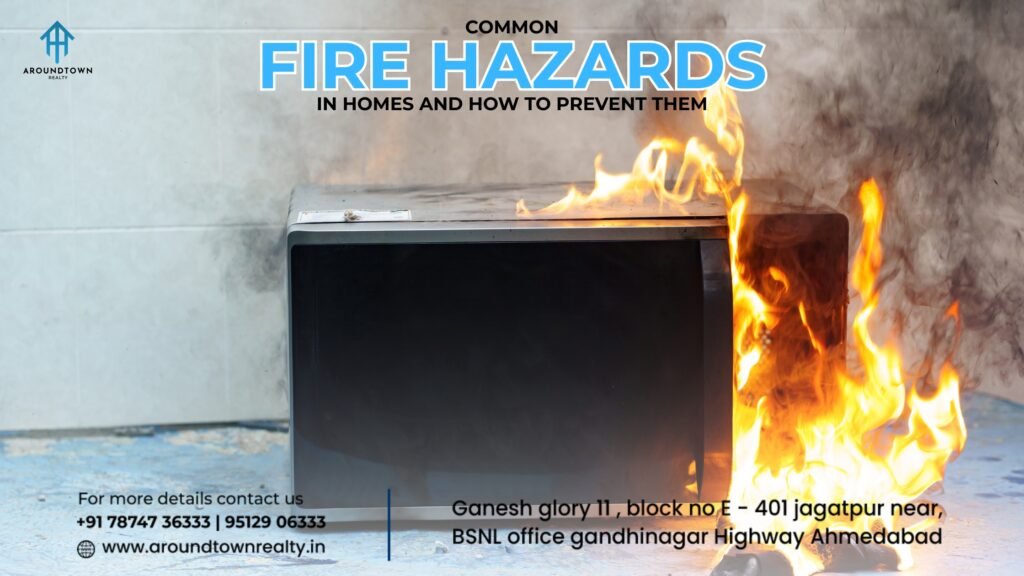Introduction: How Safe Is Your Home, Really?
Common fire hazards in homes often go unnoticed—until it’s too late. From faulty wiring and unattended gas stoves to cluttered balconies and aging appliances, your home might be hiding potential fire threats in plain sight. Especially in growing cities like Ahmedabad, where compact apartments, shared walls, and rising electrical loads are the norm, fire prevention is not just a safety measure—it’s a necessity. In this blog, we’ll walk you through the top residential fire risks and the best ways to prevent them with a detailed, humanized, and highly practical approach.
1. Electrical Fires: The Most Overlooked Threat
What Makes Them Dangerous?
Electrical faults are one of the most common causes of home fires. Worn-out wires, loose connections, and overloaded power strips can heat up quickly and ignite surrounding materials—often without warning.
Detailed Prevention Tips:
- Inspect wiring regularly—especially in older homes. Watch out for flickering lights, buzzing switches, or burning smells.
- Upgrade outdated electrical panels to meet modern load demands.
- Use only certified appliances with ISI marks and approved wiring standards.
- Avoid overloading sockets—don’t run a heater, microwave, and fridge from the same outlet.
- Install circuit breakers and surge protectors to guard against electrical surges.
- Hire licensed electricians—never DIY electrical work at home.
2. Kitchen Fires: The Fastest to Ignite and Spread
Why the Kitchen Is High-Risk:
Cooking accounts for a significant percentage of residential fires. Grease fires, gas leaks, and flammable items near the stove are some of the most frequent culprits.
Prevention Tips:
- Never leave the kitchen unattended when cooking—especially when frying or grilling.
- Keep a fire extinguisher within reach and learn how to use it.
- Clean the stove and hood regularly to prevent grease build-up.
- Install a gas leak detector—it’s inexpensive and can save lives.
- Turn off gas connections when not in use, especially overnight or during travel.
- Keep combustibles like paper towels, cooking oil, or wooden utensils away from open flames.
3. Smoking Indoors: A Preventable Danger
Hidden Risk:
Cigarettes and matchsticks can easily cause fires if not disposed of properly. A single spark near a curtain or sofa can ignite an entire room.
Smart Prevention:
- Don’t smoke indoors, especially in bedrooms or near flammable fabrics.
- Use heavy ashtrays and make sure cigarette butts are fully extinguished.
- Keep lighters and matches out of reach of children.
- Check for smoldering ashes—particularly on furniture, carpets, or bedsheets.
4. Candles and Puja Lamps: Traditional But Risky
Cultural Insight:
In Indian households, especially during festivals or daily rituals, candles and oil lamps (diyas) are often lit. But when left unsupervised, they can easily cause fire accidents.
Prevention Advice:
- Place lamps and candles on stable surfaces away from curtains and upholstery.
- Use metal or ceramic holders with a wide base to avoid tipping.
- Extinguish all flames before leaving the room or going to sleep.
- Switch to LED puja lights or battery-operated candles for daily rituals.
5. Faulty Appliances: The Fire Starters You Trust Daily
What to Watch For:
Washing machines, air conditioners, toasters, and microwaves can overheat, especially when used for prolonged periods or if they’re old.
How to Stay Safe:
- Service your appliances annually and replace worn-out plugs and cords.
- Avoid using multiple high-wattage appliances at once.
- Do not run washing machines or dishwashers overnight.
- Use surge protectors for sensitive or expensive devices.
6. Cluttered Balconies and Staircases: The Unseen Fire Accelerators
Why It’s Dangerous:
Storing items like cardboard boxes, old newspapers, or gas cylinders on balconies or stairwells is risky. In case of a fire, these act as fuel, accelerating the blaze.
Practical Prevention:
- Keep escape routes clear at all times.
- Store inflammable items like paints, sprays, and solvents away from common areas.
- Declutter balconies and remove dry leaves, cardboard, or fabrics.
- Avoid using balconies as storage spaces for LPG cylinders or old furniture.
7. Lack of Smoke Detectors: The Missed Early Warning
What It Means:
Many homes still don’t have basic fire detection systems. A smoke detector provides critical early warning, often making the difference between minor damage and a full-blown fire.
Immediate Actions:
- Install smoke detectors in all rooms, especially the kitchen and bedroom.
- Test them monthly and change batteries every 6 months.
- Invest in a fire alarm system if you live in a large apartment complex.
8. Child-Related Fire Accidents: Curiosity Meets Risk
Common Scenarios:
Children playing with matchsticks, candles, or electronic gadgets can accidentally cause fires.
How to Safeguard:
- Educate your children about the dangers of fire from an early age.
- Childproof electrical sockets, kitchen drawers, and gas knobs.
- Store flammable materials out of children’s reach.
- Supervise screen time—some mobile devices have been known to overheat or explode when overcharged.
9. Inadequate Fire Escape Plans: Delay Can Be Deadly
What It Costs:
Panic and confusion during emergencies often lead to injuries or death. Having no plan is the biggest mistake most residents make.
Simple Solutions:
- Create a fire escape plan with 2 exits from each room.
- Practice evacuation drills with your family every 3–6 months.
- Know your building’s emergency numbers and alarm systems.
- Designate a safe meetup point outside your apartment complex.
10. Absence of Fire Extinguishers: Prevention Needs Preparation
Don’t Wait for Help:
In the critical first minutes of a fire, a fire extinguisher can control the blaze before it spreads.
What You Can Do:
- Keep a multipurpose ABC extinguisher in your kitchen and near high-risk zones.
- Learn how to use it—don’t wait for a crisis to read the instructions.
- Check pressure levels regularly and replace expired extinguishers.
Conclusion: Fire Safety Is a Lifestyle, Not Just a Checklist
Common fire hazards in homes are not just about faulty wires or open flames — they’re about the everyday choices we make, from how we cook to how we plan our living spaces. In bustling urban centres like Ahmedabad, where residential clusters are growing rapidly, it’s more important than ever to prioritize fire safety as an integral part of smart homeownership.
Whether you’re investing in your first apartment, upgrading to a larger flat, or seeking a gated community that values both comfort and security, fire preparedness must be part of your checklist. From smoke detectors and fire-resistant building materials to thoughtful layouts and well-managed societies, every detail contributes to your peace of mind.
At Around Town Realty, we don’t just help you find a house—we guide you toward safe, future-ready homes that are built with responsibility and resilience. Our curated listings prioritize safety features, certified construction practices, and layouts that support modern, hazard-aware living.
FAQs: Common Fire Hazards in Homes
- What is the most common cause of home fires in India?
Electrical faults and kitchen fires are the most frequent causes of home fires in Indian households. - How often should I check my home’s wiring?
Ideally, get your wiring inspected every 2–3 years, especially if your home is more than a decade old. - Can smoke detectors really prevent a major fire?
Yes, they provide early warnings, allowing you to take action before the fire spreads. - Are fire extinguishers mandatory in residential homes?
While not mandatory by law for all homes, fire extinguishers are highly recommended for safety. - What’s the best fire extinguisher type for homes?
A multipurpose ABC dry chemical extinguisher works well for most residential fire risks.









